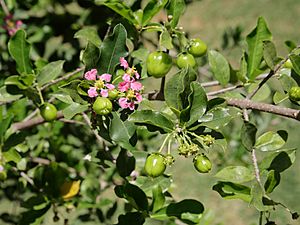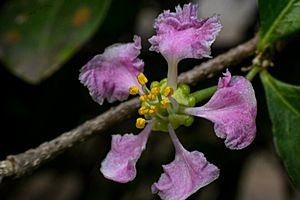West Indian cherry facts for kids
Quick facts for kids West Indian cherry |
|
|---|---|
 |
|
| Close-up of the blossom and unripe fruit | |
| Scientific classification | |
| Genus: |
Malpighia
|
| Species: |
emarginata
|
| Synonyms | |
|
|
| Nutritional value per 100 g (3.5 oz) | |
|---|---|
| Energy | 134 kJ (32 kcal) |
|
7.69 g
|
|
| Dietary fiber | 1.1 g |
|
0.3 g
|
|
|
Protein
|
0.4 g
|
| Vitamins | Quantity
%DV†
|
| Vitamin A equiv. |
5%
38 μg |
| Thiamine (B1) |
2%
0.02 mg |
| Riboflavin (B2) |
5%
0.06 mg |
| Niacin (B3) |
3%
0.4 mg |
| Pantothenic acid (B5) |
6%
0.309 mg |
| Vitamin B6 |
1%
0.009 mg |
| Folate (B9) |
4%
14 μg |
| Vitamin C |
2021%
1677.6 mg |
| Minerals | Quantity
%DV†
|
| Calcium |
1%
12 mg |
| Iron |
2%
0.2 mg |
| Magnesium |
5%
18 mg |
| Manganese |
29%
0.6 mg |
| Phosphorus |
2%
11 mg |
| Potassium |
5%
146 mg |
| Sodium |
0%
7 mg |
| Zinc |
1%
0.1 mg |
|
Link to USDA Database entry
|
|
| †Percentages estimated using US recommendations for adults. | |
The Acerola cherry (scientific name: Malpighia emarginata) is a small tree or shrub that grows in warm, tropical places. It's also known as Barbados cherry or West Indian cherry.
This fruit originally comes from South America, Mexico, and Central America. Now, people grow it in many other warm parts of the world, like Texas and India.
Acerola is super famous for having a huge amount of vitamin C! It also contains other important vitamins like A, B1, B2, and B3. These vitamins, along with other helpful compounds, make acerola a very nutritious fruit. They also act as antioxidants, which help protect your body's cells.
Contents
Where Acerola Grows
Acerola first came from the Yucatán area. You can find it growing naturally in Mexico, Central America, the Caribbean, and parts of South America like Peru and Brazil.
It also grows in the very southern parts of the contiguous United States, like southern Florida and the Rio Grande Valley in Texas. In Florida, it can even grow a bit further north if it's in a protected spot.
People now grow acerola in warm, tropical, and subtropical areas all over the world. This includes places like the Canary Islands, Ghana, India, Hawaii, and Australia.
How Acerola Grows
Acerola plants can be started from seeds or from cuttings (small pieces of the plant). They like dry, sandy soil and lots of sunshine.
These plants don't like cold weather. They can't handle temperatures lower than about 30 °F (-1 °C). Also, their roots don't go very deep, so they don't do well in strong winds.
What Acerola Looks Like
Acerola is an evergreen shrub or a small tree. This means it keeps its leaves all year round. It has branches that spread out from a short trunk.
Most acerola plants are about 2–3 m (6.6–9.8 ft) tall, which is like 6 to 10 feet. But some can grow taller, up to 6 m (20 ft) (about 20 feet).
Leaves
The leaves of the acerola plant are simple and shaped like an oval with a pointed end. They are usually 2–8 cm (0.79–3.15 in) long and 1–4 cm (0.39–1.57 in) wide. They grow in pairs, one across from the other, on short stems.
The edges of the leaves can be smooth or slightly wavy. They also have tiny hairs that might irritate your skin if you touch them.
Flowers
Acerola Flowers are small, about 1–2 cm (0.39–0.79 in) across. They have five petals that are light to dark pink or red and look a bit fringed. Each flower also has 10 stamens (the parts that make pollen).
These flowers grow in small groups of three to five. They can be found where the leaves meet the stem.
Fruit
After about three years, acerola trees start to produce a lot of fruit. The fruits are bright red and round, like small cherries. They are about 1–3 cm (0.39–1.18 in) across and weigh about 3–5 g (0.11–0.18 oz).
Each fruit usually grows in pairs or groups of three. Inside, each fruit has three triangle-shaped seeds. The fruits are very juicy and, as we know, super high in vitamin C! They also contain other important nutrients.
Acerola fruits are often acidic, which means they taste sour. But if they are grown well, they can be sweet too.
How People Use Acerola
As Food
The acerola fruit is safe to eat and is very popular in the places where it naturally grows. People also grow it in many other areas because of its amazing vitamin C content. Just 100 grams of the fruit can have about 1677 mg of vitamin C!
You can use acerola fruit to make juices, purees, and even baby food. It's also used to make vitamin C concentrates.
Scientists have studied how well different fruit juices fight against damage in the body (this is called antioxidant power). Out of 11 different fruit juices tested, acerola juice had the most antioxidant power!
Other Uses
Acerola is a popular plant for bonsai, which is the art of growing miniature trees. It's good for bonsai because it has small leaves and fruits, and its branches grow in a nice, detailed way.
People also grow acerola as an ornamental plant to make gardens look pretty. It can also be used to create hedges.
Acerola and Nature
Malpighia emarginata is a "host plant" for the caterpillars of certain butterflies and moths. This means the caterpillars eat the leaves of the acerola plant. Some of these caterpillars include the white-patched skipper, Florida duskywing, and brown-banded skipper.
There's also a tiny bug called the acerola weevil. Its young (larvae) eat the fruits, and the adult weevils eat the young leaves. When wild insects help pollinate the flowers, the plant makes more fruit.
Images for kids
See also
 In Spanish: Malpighia emarginata para niños
In Spanish: Malpighia emarginata para niños




